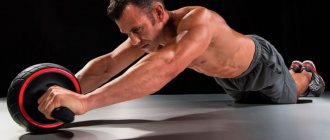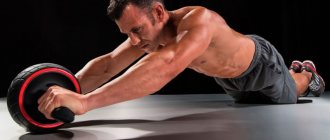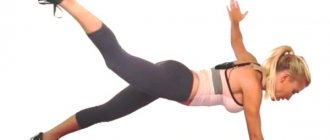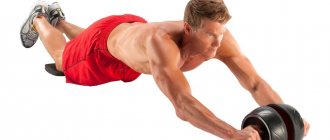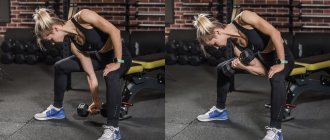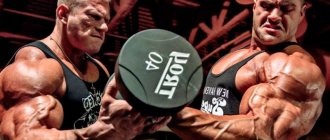Side crunches[edit | edit code]
Source: “Strength training for girls”
.
Illustrated manual. Posted by
Frédéric Delavier, 2016
Areas of Muscle Activation When Performing a Twist
The lateral twist is classified as an isolation exercise. The muscles surrounding the abdominals are practically not used here.
The side crunch differs from the oblique crunch in that you lie on your side instead of your back. This exercise uses the obliques more actively than the oblique crunch, where the rectus abdominis and obliques are used approximately equally.
Performance
Lie on the floor with your left side. Place your right hand behind your head. Using your oblique abdominal muscles, try to bring your right elbow closer to your right thigh. The left elbow should rise above the floor by about 2-3 centimeters. Hold this position for 1-2 seconds, then lower your torso. Lower your left shoulder to the floor, but do not lower your elbow. This will help maintain constant tension in the oblique abdominal muscles. After completing the exercise on the left side, repeat it on the right side.
Advantages
- This is the best exercise for the obliques.
- If you do it correctly, you will immediately feel the muscles working.
Flaw
- Using heavy weights to perform side crunches can build up your obliques, but massive obliques and, therefore, a wide waist don't make a woman look good. If you don't do strength sports, don't use too much weight when training your obliques. Light weights with high repetitions will help remove the fat that collects so easily in this area of the body.
By arching your back, you force the wrong muscles to work that you want to work, and you also pinch the intervertebral discs of the lower back. Try not to suddenly jerk your head to perform a few extra reps; in this case, you risk injuring the cervical vertebrae.
Recommendations
- Tighten your oblique abdominal muscles and slightly turn your torso forward. This exercise should not be performed by lifting the torso in a straight line in one plane.
- Place your left hand on your obliques to get a better feel for how they work.
- Don't start your abdominal workout with side crunches. It's best to end the session with this exercise, since you should first of all work on the rectus abdominis muscles.
Options[edit | edit code]
- The position of the free hand determines the degree of difficulty of the exercise. The option with a hand behind the head is intermediate. To increase the load, extend your arm, moving it away from your body but keeping it close to your head. To reduce the load, extend your arm toward your hip, parallel to your body. Try performing the exercise with different hand positions. Start with your arm straight above your head, then as you get tired, bring it behind your head for a few extra reps. When you get tired again, extend your arm parallel to your body and continue doing the exercise. Using this technique, you can achieve a deep degree of muscle fatigue. In this case, you will only need one approach on each side, which will save time.
- You can perform side crunches using a rocker to help you find the correct range and trajectory.
- To increase the load, you can perform side crunches on a Roman chair.
- The rocking chair will help you find the best option for contracting the oblique abdominal muscles.
- By performing the exercise not on the floor, but on a Roman chair, you can increase the load on the oblique abdominal muscles.
- We strongly recommend against performing standing side bends using dumbbells or a cable machine in the low position, as this places unwanted stress on the spine and places the back in a very uncomfortable position. These exercises can only be used for training in strength sports, where the spine must withstand enormous loads. In this case, place the cable machine in the upper position to reduce the strain on your lower back. Moreover, perform this exercise only on one side at a time, do not use two dumbbells at the same time.
- Lateral twisting in the simulator
- Lateral crunch on a cable machine
Inclusion in the program
The exercise can be included in at least every strength training session, especially if you do them no more than 3-4 times a week. The more often this movement appears in the program, the more likely it is that oblique hypertrophy will be achieved. For those for whom this is not a priority, it is enough to train the obliques once a week.
Usually, the oblique muscles are trained after the straight muscles and strictly at the end of the training complex.
The number of repetitions is determined individually, depending on the athlete’s form, and the number of approaches can be from 2 to 4.
If an athlete performs strength training regularly and with great dedication, and includes basic exercises in his training, he should refuse to train this movement immediately after a deadlift or squat. Typically, such athletes are recommended to perform this exercise at the beginning, as part of a warm-up, in a small volume.
The exercise may not be included in the program if the obliques are normally developed and no additional effort is required.
Those who do not want to increase the size of their waist are recommended to perform the exercise statically, and simply remain in the side plank or T-pose, and not do twisting.
The weight of the weights should be carried in your free hand, and it is recommended to use no more than a third of your body weight, even if you are an experienced athlete. Athletes must balance their efforts with the fitness they have.
Technique for performing lateral twists[edit | edit code]
Source:
“Bodybuilding.
Book trainer" .
Editor:
Oksana Usoltseva
Ed.
: Eksmo 2013
Inventory
: gymnastic mat.
Core muscles
: oblique abdominal muscles.
Additional muscle
: rectus abdominis muscle.
Level of training
: average.
- Step 1
. Lying on your side, legs slightly bent and pressed to the floor. One arm is straightened forward and rests on the floor, the second is behind the head. - Step 2
. Slowly twist your upper torso. Pause at the top. - Step 3
. Slowly return to the starting position.
What muscles work
When working on the press, it is impossible to achieve complete isolation. Therefore, the essence of each movement is to shift the load to a specific area.
Main areas involved:
- External and internal obliques.
- Transverse.
- Straight.
Despite the fact that the main load falls on the obliques, the rectus muscle is also involved and receives a certain load.
Lateral crunches on a fitball[edit | edit code]
Inventory
:fitball.
Core muscles
: oblique abdominal muscles.
Additional muscles
: rectus abdominis, lumbar.
Level of training
: average.
- Step 1
. Fix your feet on the floor. Place the body on the fitball, slightly unfolding it. - Step 2
. Slowly lift your torso, turning it to the right side and twisting around its own axis. - Step 3
. Return to the starting position, then perform the movement in the other direction.
Benefits and disadvantages of exercise
Side crunches are an example of an exercise that has no disadvantages. The isolation movement provides targeted work on the target area and does not require the use of weights.
Main advantages:
- Versatility - can be performed in any environment (gym, home, sports ground, etc.).
- Maximum development of the oblique abdominal muscles.
- Completely safe movement.
- Suitable for athletes with any level of physical fitness.
- Working on the deep layers of muscles and improving posture.
- Allows you to form “teeth” on the side press, which are visible with low fat levels.
The only drawback is related to technique and incorrect application. If done incorrectly, lateral crunches on the oblique muscles can visually expand the waist, which can be considered a disadvantage. This occurs when athletes use a lot of weight and perform a power-style movement. When working with multiple repetitions, there are no such disadvantages. This option is recommended when performing abdominal exercises for girls, as well as for men for whom it is important to maintain a narrow waist.
Cobra Pose Stretch
After an intense ab workout, it's important to take a few minutes to stretch. The cobra pose will help you relax your muscles and recover.
Initial position:
lying on your stomach, legs straight, arms bent under your chest.
Straighten your arms and smoothly lift your body. Arch your back, aiming the back of your head towards your feet. Do not lift your pelvis off the floor. Control your lower back: there should be no pain in it. If you can’t bend without lifting your pelvis, move your hands forward a little so that you can feel the front line of your body.
How to make your abdominal workout more effective?
Perform each exercise for 3-5 approaches. It is important to take a short pause between them - no more than 40 seconds. This way you can get the most out of your workout.
In pursuit of six packs: why you shouldn’t train your abs every day
Be sure to monitor your own feelings. Any discomfort in the neck, lower back or hip joints indicates that it is necessary to change the range of motion. A burning sensation in the abdomen is considered normal.
And don’t forget: it’s impossible to achieve relief through sports alone. Add a proper diet and a well-established daily routine to regular exercise, create an optimal calorie deficit to reduce body fat, and six-pack abs will not be long in coming.
Contraindications
At first glance, this movement looks harmless, but it should not be performed if you have any problems with the spine. It can lead to displacement of the vertebrae. Those who have hernias and protrusions should refuse the exercise.
Those who have rectus diastasis after pregnancy should also avoid performing this exercise. You should activate your core in other ways, such as doing planks.
Exercise 4. Bicycle
Technique.
Lying on the floor, bend your knees slightly and cross your arms at the back of your head. We press the lower back tightly to the floor and do not tear it off throughout the entire approach, so as not to create unnecessary stress on the spine. We move our legs, simulating pedaling when riding a bicycle: the knees should move towards the chest. At the same time, we turn the body a little, slightly rounding the back, and try to reach the knee with our elbow. We work diagonally - we try to reach the left knee with our right elbow, and the right knee with our left elbow.
Contraindications:
recent operations; heart diseases; hernias
How to do reverse crunches
There are several options for performing the exercise: on the floor, on a bench and hanging (on parallel bars or a horizontal bar). In any of these options, it is important to monitor the position of the lower back: do not overload it, work more actively with your abdominal muscles.
“When performing hanging crunches, for example, try to tense your abs as much as possible, not your leg muscles ,” adds Valentin Zinin.
Also, you should not work due to inertia . “In the exercise with lifting the pelvis and straight legs, do not use inertia, do not “throw” your feet back. Try to activate the abdominal muscles,” says Valentin Zinin.
Breathe correctly: make the main effort while exhaling and do not hold. “This increases intracranial and intra-abdominal pressure,” notes Valentin Zinin.
The benefits of diagonal twists
By performing side crunches, you will receive a number of benefits:
- strengthening the rectus and oblique abdominal muscles;
- burning excess weight;
- the appearance of outlines and relief of the figure;
- toning muscle mass;
- improved blood circulation;
- removal of salt deposits;
- speed of result;
- ease of implementation;
- no need for special sports training.
The importance of the abdominal muscles
From a functional point of view, it is better to strive not for “cubes”, but for a flat and retracted stomach.
To achieve this result, you need to strengthen mainly the transverse abdominal muscle, that is, the deep layer of the abdominal muscles. But the rectus muscle, which is “turned on” by twisting, is superficial. Fully realizing its potential, the abdominal press stabilizes the musculoskeletal system and compensates for the load on the spine, flexes it, helps with breathing, affects blood circulation, the digestive and genitourinary systems. Its upper dome is the thoraco-abdominal diaphragm. It is responsible for the location and mobility of the ribs. The esophagus, aorta and inferior vena cava pass through the diaphragm. The lower diaphragm separates the pelvic organs from the perineum and is responsible for the functioning of the genitourinary and reproductive systems.
The correct diaphragmatic position allows you to optimize intra-abdominal pressure and reduce compression from the intervertebral discs when they are compressed and any external provocations (sudden movements, heavy hands, turns). The abdominal muscle complex keeps the internal organs in the correct position, which improves their trophism and functioning, and prevents the appearance of congestion and neurological disorders.
Main mistakes
Crunches (these are movements that bring the thoracic region closer to the pelvis) are very common, but most often they are done with many mistakes, without understanding how this exercise “works” and what it is designed for.
Many people simply twist the body for many repetitions at high speed. Thus, the rectus muscle, which is attached to the chest along the xiphoid process and to the pubic bone, brings them closer to each other, “lowers” the ribs, contributing to unwanted transformations of the body. In addition, mistakes include putting pressure on the back of the head with your hands, as well as excessively involving the hip flexors (this happens, for example, when raising the legs while hanging, which is considered an abdominal exercise and which is very difficult to perform with the abs). When working with the press, you should understand that you need to train it all - entirely.

